Suchergebnisse
Joining Cards - Untersuchung rückbaubarer Verbindungs- und Fügetechniken zur Entwicklung monomaterieller Innenausbausysteme aus Karton
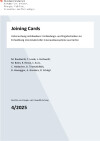
Strategische Auseinandersetzung mit Kartonprodukten und Papierwerkstoffen zur Entwicklung rückbaubarer Innenausbausysteme und der Definition von Baukomponenten und ihrer Schnittstellen. Das Ergebnis bildet in Form eines umfassenden Erkenntnisgewinns die Grundlage für weiterführende Forschungsprojekte.
Schriftenreihe
4/2025
M. Raudaschl, T. Levak, L. Gschweitl, M. Boles, R. Riewe, C. Kurz, C. Haidacher, G. Triantafyllidis, B. Hausegger, A. Gündera, D. Schlegl
Herausgeber: BMK
Deutsch, 66 Seiten
Downloads zur Publikation
Ökonomisch optimiertes Regelungs- und Betriebsverhalten komplexer Energieverbünde zukünftiger Stadtquartiere (ÖKO-OPT-QUART)
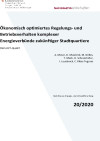
Im Projekt ÖKO-OPT-QUART wurden energietechnische, ökonomische und regelungstechnische Modelle zur Simulation der Betriebsführung komplexer, nachhaltiger Energieverbünde für Stadtquartiere entwickelt. Diese Modelle werden danach für eine Beispielkonfiguration zu einem umfassenden Gesamtmodell kombiniert und erlauben einen realistischen ökonomischen Vergleich verschiedener Regelungsstrategien. Das übergeordnete Ziel des Projekts ist die Entwicklung einer Methode zur systematischen Erstellung kostenoptimierender, vorausschauender Regelungsstrategien für komplexe Energieverbünde in Stadtquartieren.
Schriftenreihe
20/2020
A. Moser, D. Muschick, M. Gölles, T. Mach, H. Schranzhofer, I. Leusbrock, C. Ribas Tugores
Herausgeber: BMK
Deutsch, 67 Seiten
Downloads zur Publikation
Effiziente Lösungen für Photovoltaik-Energiemanagement basierend auf Blockchain-Technologie (SonnWende+)
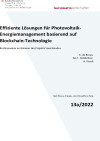
Das Projekt analysiert Blockchain-Technologie im Kontext erneuerbarer elektrischer Einspeisung und Flexibilität im Innovationslabor "Energie Innovation Cluster Südburgenland". Ziel ist die Erforschung neuer und effizienter Lösungen für Energiemanagement-Services und Energiehandel.
Schriftenreihe
13/2022
M. Stefan, R. Hemm, R. Graf, P. Zehetbauer, T. Tötzer, R. Schmidt, M. Niederkofler, T. Zeinzinger, M. Holzleitner, A. Veseli
Herausgeber: BMK
Deutsch, 75 Seiten
Downloads zur Publikation
Innovationen für die grüne, smarte Stadt der Zukunft! GRÜNSTATTGRAU - Das grüne Innovationslabor
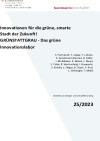
GRÜNSTATTGRAU ist die ganzheitliche Kompetenzstelle für Bauwerksbegrünung in Österreich: Sie gibt Impulse und vernetzt innovative Produkte und Projekte, liefert Know-How und Analysen für die Praxis und begleitet urbane und partizipative Entwicklungsstrategien bis zur Umsetzung.
Schriftenreihe
25/2023
S. Formanek, T. Szalay, T. Lošonc, E. Gruchmann-Bernau, G. Hofer, I. Mühlbauer, K. Mauss, I. Zluwa, S. Telek, R. Werluschnig, I. Haymerle, S. Kotrba, L. Steger, B. Seyer, V. Enzi, L. Steininger, T. Matić
Herausgeber: BMK
Deutsch, 225 Seiten
Downloads zur Publikation
Optimiertes Regelungs- und Betriebsverhalten thermisch aktivierter Gebäude zukünftiger Stadtquartiere (ÖKO-OPT-AKTIV)
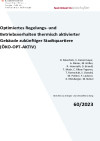
Entwicklung und Simulation skalierbarer, verteilter Regelstrategien zur Nutzung der Speicherwirkung thermisch aktivierter Bauteile in Gebäuden zukünftiger Stadtquartiere bei deren Energieversorgung durch eine Energiezentrale.
Schriftenreihe
60/2023
D. Muschick, V. Kaisermayer, A. Moser, M. Gölles, R. Heimrath, D. Brandl, T. Mach, C. Ribas-Tugores, T. Ramschak, S. Oswald, M. Polster, F. Lackner, K. Eibisberger, M. Nebel
Herausgeber: BMK
Deutsch, 76 Seiten
Downloads zur Publikation
Energieschwamm: Das Gebäude als Energieschwamm - Strom rein - Wärme raus
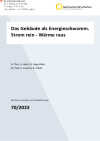
Ziel war die Entwicklung und Demonstration in Praxistests von innovativen, dynamischen Regelungskonzepten in Kombination mit (Außenluft-) Wärmepumpen, welche durch Einzelraumregelung mit Überhöhungen bzw. Absenkungen von Raumtemperaturen zu einer bestmöglichen Wärmespeicherung von Strom (PV-Eigenverbrauch bzw. Netz-Überschussstrom) in der Gebäudemasse von Mehrfamilien-Gebäuden bei bestmöglichen aber auch variablen Komfortparametern führen. Wichtige Faktoren und Motivatoren für die Nutzerakzeptanz sollen ermittelt werden, als Basis für die Entwicklung von potentiell erfolgreichen Geschäftsmodellen.
Schriftenreihe
70/2023
A. Thür, A. Heinz, R. Ungerböck, W. Pink, K. Fuetsch, B. Schett
Herausgeber: BMK
Deutsch, 69 Seiten
Downloads zur Publikation
fit4power2heat - Sondierung zur Realisierung des Wärmepumpenpooling für städtische Wärmenetze
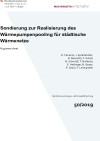
Die Integration von Wärmepumpen kann die Wirtschaftlichkeit bestehender Wärmenetze erhöhen und gleichzeitig den hohen Kosten für den Ausbau der Stromnetze entgegenwirken. Ziel des Projektes ist es, innovative Geschäftsmodelle für kleine und mittlere städtische Wärmenetze zu entwickeln, insbesondere hinsichtlich der Synergien zwischen Wärme- und Strommarkt. Hauptfokus ist die Anwendung eines Wärmepumpen-Poolings über mehrere Wärmenetze.
Schriftenreihe
50/2019
O. Terreros, J. Spreitzhofer, D. Basciotti, T. Esterl, R. Schmidt, T. Natiesta, E. Haslinger, R. Geyer, P. Leoni, F. Leimgruber
Herausgeber: BMVIT
Deutsch, 70 Seiten
Downloads zur Publikation
Photonic Cooling - Effizientere Gebäudekühlung durch Nutzung von Photonik
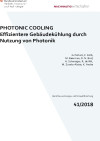
In diesem Sondierungsprojekt wurde der Ansatz des Photonic Cooling zur Gebäudekühlung auf seine praktische und kostengünstige Umsetzbarkeit und im Bezug zu seiner Wirkung bewertet.
Schriftenreihe
41/2018
Gerhard Peharz, Florian Kolb, Martin Beerman, David Neil Bird, Hannes Schwaiger, Rosmarie de Wit, Maja Zuvela-Aloise, Konrad Andre
Herausgeber: BMVIT
Deutsch, 107 Seiten
Downloads zur Publikation
Sondierung für PV-Fassadensysteme aus leichten Kunststoff-Modulen mit reversiblen Befestigungen für Neu- und Altbauten (PV-FAS_light+easy)
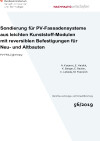
Sondierung für ein neues einfaches, kostengünstiges und gebäudeintegrierbares PV-Fassaden-System aus Kunststoff-PV-Modulen durch erste Untersuchungen zur Befestigungstechnik, zur Bauphysik, zum Brandschutz und zur Elektrotechnik um die Gebrauchstauglichkeit, die Anwendbarkeitsbereiche und das Ertrags- und Anwendungspotenzial für den Neubau und für Bestandsgebäude beurteilen zu können.
Schriftenreihe
56/2019
A. Korjenic, E. Heiduk, K. Berger, E. Rauter, C. Lebeda, M. Fraisslich
Herausgeber: BMVIT
Deutsch, 70 Seiten
Downloads zur Publikation
Thermisch optimierte Balkonsanierung (THERM-opti-BALKON)
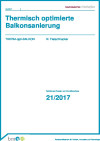
Bei der thermischen Sanierung von Gebäuden stellen frei auskragende Balkone ein besonderes Problem dar. Das Projekt hatte zum Ziel, die Grundlagen für die Entwicklung eines praxistauglichen und kostengünstigen Befestigungssystems zu schaffen, das die thermisch entkoppelte Wiedererrichtung der Balkone im Zuge der Sanierung erlaubt und damit die Effizienz der Wärmedämmmaßnahme deutlich verbessert.
Schriftenreihe
21/2017
N. Fleischhacker Berichte
Deutsch, 59 Seiten
Downloads zur Publikation
Residential Area Augmented Reality Acoustics (RAARA)
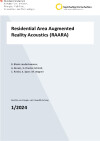
Lärm bedeutet Ärger. Um die Schallimmissionen auf die Bevölkerung im urbanen Gebiet zu minimieren, wurden im Projekt Methoden entwickelt, die einen einfachen, intuitiven und zugleich akkuraten Umgang mit Schallemissionen und deren Minderung ermöglichen. Ziel ist, die Lärmquellen vor deren Installation VOR ORT in realer Umgebung mittels Augmented Reality virtuell zu platzieren und die Schallemissionen visuell farblich darzustellen und hörbar zu machen. Dieser einzigartige Ansatz erleichtert die Planung von erneuerbaren Heiz- und Kühlgeräten, erhöht die Akzeptanz und damit den Anteil erneuerbarer Energien und senkt den Lärmpegel in Städten.
Schriftenreihe
1/2024
B. Blank-Landeshammer, A. Buruzs, G. Drexler-Schmid, C. Reichl, A. Sporr, M. Wagner
Herausgeber: BMK
Deutsch, 33 Seiten
Downloads zur Publikation
Optimierung der Gebäudeenergieeffizienz durch modellbasierte Energiestromanalyse mit non-invasiver Sensorik
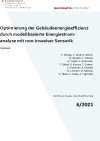
OptiMAS untersuchte, wie durch eine modellbasierte Energiestromanalyse und unter Verwendung von Anlegesensorik bestehende Gebäude überwacht, analysiert und optimiert werden können, unabhängig von den darin verwendeten HLK-Systemen und deren Automationskomponenten.
Schriftenreihe
6/2021
F. Wenig, C. Seidl, B. Derler, D. Rixrath, C. Heschl, A. Treytl, S. Cerimovic, T. Glatzl, G. Kovacs, T. Sauter, L. Krammer, K. Diwold, D. Lechner, D. Molnar, S. Tkauz, S. Cejka, A. Lugmaier
Herausgeber: BMK
Deutsch, 77 Seiten
Downloads zur Publikation
Scanning and data capturing for Integrated Resources and Energy Assessment using Building Information Modelling (SCI_BIM)
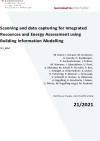
Ziel dieses Projekts ist, durch Kopplung unterschiedlicher digitaler Technologien und Methoden zur Datenerfassung- (Geometrie und materielle Zusammensetzung) und Modellierung (as-built BIM) die Steigerung der Ressourcen- und Energieeffizienz mittels Gamification Ansatz zu ermöglichen.
Schriftenreihe
21/2021
M. Honic, I. Kovacic, M. Sreckovic, G. Gourlis, H. Rechberger, P. Aschenbrenner, J. Fellner, M. Wimmer, I. Gilmutdinov, U. Pont, A. Mahdavi, M. Schuß, P. Ferschin, P. Kan, I. Schlögel, A. Hinterleitner, K. Löcker, R. Totschnig, P. Meixner, I. Greussnig, S. Schmidt, H. Steiner, G. Uhlariova, A. Ragoßnig, K. Kondracki, J. Maier, U. Moroz, M. Ragoßnig-Angst, M. Raskovic
Herausgeber: BMK
Deutsch, 62 Seiten
Downloads zur Publikation
Metadaten und Prozessmodelle für Open BIM in der TGA
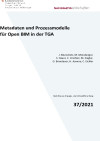
Ziel dieses Projektes ist es, eine Methodik für die Entwicklung von Daten- und Prozessmodellen zu konzipieren und diese zur Modellierung ausgewählter TGA (Technische Gebäudeausrüstung)-Systeme exemplarisch anzuwenden. Dazu werden schwerpunktmäßig, jedoch nicht ausschließlich, die erneuerbaren Heizungstechnologien Wärmepumpe, Solarthermie und Biomasse sowie Lüftungssysteme betrachtet. Die entwickelten Daten- und Prozessmodelle werden im Rahmen von zwei Pilotprojekten evaluiert. Die Projektergebnisse werden in einem TGA-BIM-Leitfaden publiziert und in BIM-Arbeitsgruppen in relevanten Gremien eingebracht.
Schriftenreihe
37/2021
J. Murschetz, M. Monsberger, S. Hauer, C. Urschler, M. Ziegler, G. Brandauer, H. Asmera, C. Eichler
Herausgeber: BMK
Deutsch, 48 Seiten
Downloads zur Publikation
Plug&Play Storage of Photovoltaic Power (P3Power)
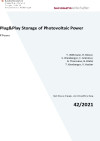
Im Projekt P³Power wird die Messtechnologie NetDetection (Abschätzung des Leistungsverbrauchs an einer Phase von einem beliebigen Messpunkt, z.B. einer Steckdose, in einem Haushalt) entwickelt. Auf Basis dieser Technologie werden plug&play Photovoltaik- und Speichersysteme realisiert, welche 100% Eigennutzung innerhalb beliebiger Aggregationsgrößen - vom Mehrfamilienhaus bis zur Gemeinde - ermöglichen ohne bestehende Installationen adaptieren zu müssen. Die Technologie wird digitalisiert, im Laborumfeld und in Realhaushalten getestet und zu einem umfassenden Energie-Service-Angebot weiterentwickelt.
Schriftenreihe
42/2021
Y. Wittmann, H. Bieser, S. Weinberger, C. Grimmer, B. Thormann, B. Böckl, T. Kienberger, V. Hacker
Herausgeber: BMK
Deutsch, 48 Seiten
Downloads zur Publikation
The Green P - Nutzung von städtischen Verkehrsflächen für die Produktion von Biomasse
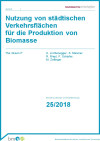
Zahlreiche Verkehrsflächen im städtischen Umfeld werden nur einen geringen Teil der Zeit tatsächlich genutzt. Inhalt dieses Projekt war, die Möglichkeit zu untersuchen, solche Flächen durch Integration von Photobioreaktoren zusätzlich zur Produktion von Biomasse zu nutzen und die Systeme möglichst vollständig in die urbanen Stoff- und Energiekreisläufe einzubinden.
Schriftenreihe
25/2018
K. Lichtenegger, K. Meixner, R. Riepl, F. Schipfer, M. Zellinger
Herausgeber: BMVIT
Deutsch, 73 Seiten
Downloads zur Publikation
GameOpSys - Gamification für die Optimierung des Energieverbrauchs von Gebäuden und übergeordneten Systemen
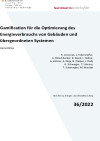
Zentrales Ziel ist die Entwicklung einer mobilen Anwendung, welche durch Partizipation des Nutzers und der Nutzerin als neue Daten- und Informationsquelle die Energieoptimierung und Planung von Gebäuden, Quartieren und übergeordneten Energiesystemen ermöglicht. Die Entwicklung der Anwendung erfolgt stark transdisziplinär und integriert dabei mathematische Methoden der Simulation und Optimierung sowie psychologische Aspekte des Nutzerverhaltens um neue Geschäftsmodelle zu erarbeiten und neue Märkte zu erschließen.
Schriftenreihe
36/2022
K. Corcoran, L. Eckerstorfer, A. Fleischhacker, B. Glock, I. Hafner, G. Lettner, A. Noja, N. Popper, J. Radl, G. Schweiger, T. Schranz, T. Schwengler, M. Wastian
Herausgeber: BMK
Deutsch, 50 Seiten
Downloads zur Publikation
Energieeffizientes Beleuchtungssystem für den Menschen durch innovative Komponentenoptimierung und Tageslichtintegration (LessIsMore)
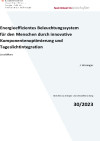
Human Centric Lighting (HCL) stellt die positiven visuellen und biologischen Wirkungen des Lichtes auf den Menschen in den Mittelpunkt, verbraucht dabei aber sehr viel Energie durch den ineffizienten Einsatz von Beleuchtungskomponenten sowie unzureichende Nutzung von Tageslicht. In LessIsMore wird testweise eine vorbildhafte HCL-Beleuchtung installiert und evaluiert.
Schriftenreihe
30/2023
J. Weninger
Herausgeber: BMK
Deutsch, 50 Seiten
Downloads zur Publikation
Subtraction as a measure to Preserve and Insulate historic Developments by Electric Robots (SPIDER)
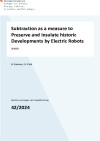
In dieser Sondierung soll das Potential von autonomen, daten-getriebenen Robotern erschlossen werden, die in einem andauernden kontinuierlichen Prozess thermische Performanceverbesserungen durch Schaffung von dämmenden Lufteinschlüssen erzielen.
Schriftenreihe
42/2024
B. Sommer, U. Pont
Herausgeber: BMK
Deutsch, 84 Seiten
Downloads zur Publikation
Fensterprototypen mit integriertem Vakuumglas (FIVA)
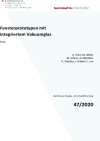
Das gegenständliche Projekt widmet sich der Fortentwicklung von Fenstern mit Vakuumgläsern. Vakuumgläser zeichnen sich durch sehr niedrige Ug-Werte und sehr schlanke Glasstärken aus und stellen damit eine neue Alternative für die Hebung des Energieeffizienz-Potentials von transparenten Bauteilen der Gebäudehülle dar. Im Projekt wird auf Erfahrungen hinsichtlich verschiedener Aspekte aus vorangegangen Sondierungsprojekten zurückgegriffen und mit Wirtschaftspartnern an der Realisierung von Funktionsprototypen gearbeitet.
Schriftenreihe
47/2020
U. Pont, M. Wölzl, M. Schuss, A. Mahdavi, P. Schober, J. Haberl, C. Lux
Herausgeber: BMK
Deutsch, 87 Seiten
